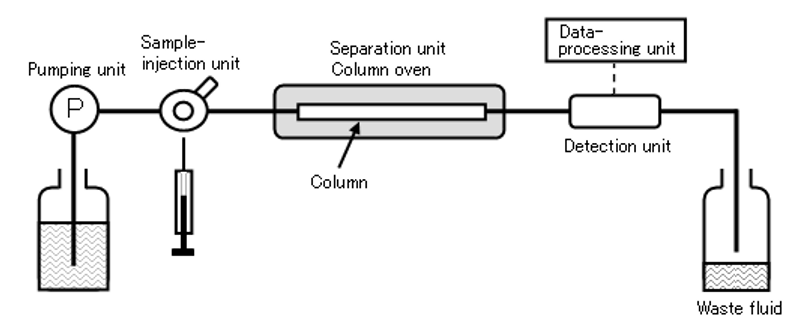In recent years, high-performance liquid chromatography (HPLC) has been used more and more widely in conventional drug analysis and detection. The 1975 edition of the "United States Pharmacopeia" (19th edition) included HPLC as a standard analysis method for the first time, and there were only 6 varieties at that time. By the 20th edition, 80 items were included, and the 21st edition increased to 418. The number continued to increase and reached 1,441 in the 22nd edition. Currently, more than 2,000 varieties are included in the pharmacopeia.

System Configuration of HPLC
Which analysis is suitable for HPLC?
- Drug content testing. The chemical components of natural medicines are complex, and there may be one or more active ingredients. Therefore, the precise determination of the content of each active ingredient is of great significance to the quality control of medicines and the establishment of quality standards. HPLC has the characteristics of specificity, high sensitivity, quickness, and simplicity, and can be widely used in pharmaceutical quantitative analysis. It can show greater superiority when there are many interference factors.
- Pharmacodynamic testing: pharmacokinetics research, new drug efficacy research.
- Drug residue testing
- High-throughput screening of active substances
- Purified active ingredients of drugs:
➢ High value-added products (such as drugs for treating cancers, like paclitaxel and vinblastine);
➢ Products with large sample amount and low added value (pharmaceutical excipients with low added value such as steviol glycosides);
➢ Process improvement products (to increase production or improve product purity)
The application of HPLC in the field of anti-counterfeiting drugs has developed rapidly. Counterfeit drugs and inferior drugs are one of the important issues that plague the development of global drugs, and they have been taken seriously by governments of various countries. About 6% of drugs in global drug sales are counterfeit and inferior products. HPLC is one of the most effective testing instruments for the crackdown on counterfeit and inferior drugs.
HPLC is also widely used in the field of chiral drugs. At present, there are asymmetric carbon atoms in the molecular structure of many organic drugs, also known as chiral carbon atoms. Such drugs are optically active. Enantiomers with different stereo configurations often have different pharmacological effects and toxic side effects. An enantiomer often has strong biological activity and efficacy, while the other has no efficacy or even toxicity.
The enantiomers have the same physical and chemical properties under normal conditions, so it is difficult to separate the enantiomers and needs to be carried out under chiral resolution conditions. For example, most amino acids have a right-handed body and a left-handed body, but often it is a mixture of the two (racemate) that is obtained. Chloramphenicol (with 2 chiral carbons), only the D-(-) isomer is effective, while the L-(+) isomer is completely ineffective. In 1992, the US FDA stipulated that the preclinical research of new drugs must separate chiral isomers. It can be done by HPLC and is of great significance in the preparation and quality control of drugs.
HPLC combined with other technologies
At present, many are exploring the possibility of combining HPLC with other technologies since HPLC has good separation efficiency and can separate many complex system samples. HPLC can be easily combined with many instruments such as spectroscopy, chromatography, and mass spectrometry to form a new analysis system. Some examples are HPLC-AAS (High-Performance Liquid Chromatography-Atomic Absorption Spectroscopy), HPLC-UVS (High-Performance Liquid Chromatography-Ultraviolet Visible Spectroscopy), HPLC-AFP (High-Performance Liquid Chromatography-Atomic Fluorescence Photometer), HPLC-MS (High-Performance Liquid Chromatography-Mass Spectrometry), HPLC-IR (High-Performance Liquid Chromatography-Infrared Spectroscopy), HPLC-NMR (High- Performance Liquid Chromatography-Nuclear Magnetic Resonance), HPLC-Sers Raman (High-Performance Liquid Chromatography-Surface Enhanced Raman Spectroscopy), and so on.
These HPLC combined systems can solve analytical problems that the single instrument in the combined system cannot. For example, according to the different physical and chemical properties of the elements to be measured, HPLC combined with AAS or AFP can realize the separation, analysis, and detection of inorganic and organic heavy metal compounds in food and drugs. It has the advantages of good separation effect, rapid, and simple.






